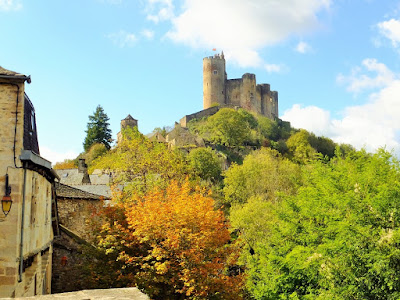France's Aveyron department boasts having the most officially designated Plus Beaux Villages in the country, and our recent trip to the Massif Central includes a planned visit to one of them: Najac. We stop in Najac on our way to Rodez, where we'll base ourselves for a few days. A few days later we'll head to Laguiole, one of the Aubrac region's most notable village.
 |
| The Royal Fortress of Najac is our destination as we head down the village's charming main street. |
 |
| Ken laughs when I tell him that we're going to walk up to Najac's Forteresse Royale. |
No one is doing much traveling these days, but we manage to sneak in a short vacation between rentrée (when children return to school) and confinement (known in the U.S. as lock-down or quarantine). The winding roads to Najac add about an hour to our road trip, but there's no doubt that the detour is worth it. We easily park in the village and after a stop at the Tourist Office, we head off to find lunch. We choose well, with both of us enjoying our lunch (salad for me, a burger for Ken) at L'Insolite, a small restaurant that could have been at home in laid-back Sausalito.
 |
| My fresh salad at L'Insolite in Najac is scrumptious. |
 |
| Najac's war monument stands in Place du Barry, known as Place du Faubourg 500 years ago. |
 |
| Maison du Gouverneur was the residence of the Royal Administration and wealthy merchants. |
Our map is needed not so much for navigation, because there's only one road through the village, but it's useful as a guide to the local landmarks. The Maison du Gouveneur, for example, is a striking building, originally home to the Royal Administration, and subsequently of several noble merchant families.
 |
| This pretty garden wall catches my attention in Najac. |
Located on a ridge and surrounded by forests, Najac was once a strategic outpost. Its 13th-century château was part of a network of royal fortresses built to defend the Rouergue province. At the time, Najac was the capital of this region. The castle's circular dungeon, is the tallest in France. From its terrace, there are beautiful views across the Aveyron.
 |
| The mountains surrounding Najac are breaking out in fall colors. |
Descending from the château, we come to Église Saint-Jean l'Evangeliste, a church built in the Languedoc-gothic style. Dominican inquisitors ordered villagers to help with its construction as retribution for their heresy. One of the church's walls is actually part of Najac's fortified walls.
 |
| Just beyond this stone gate in Najac is Quartier de la Pause, an ancient rest area on a medieval (formerly Roman) road. |
Our stroll through Najac has taken us down, up, down, then up again to the top of the village where we find our car and continue our trip to Rodez.
 |
| En route to Laguiole, we meet a stunning and quite polite herd of cows on their way to another pasture. |
Two days later, after visiting the wolves at Les Loups du Gévaudan park, we continue our drive in the Aubrac toward the village of Laguiole. Known for its knives and signature cheese, Laguiole is another important and beautiful village of this region. We park in a lot in the center of town, a plaza in which a large bronze bull stands.
 |
| Ken poses next to the big bronze bull in Laguiole. |
My advance research says that we mustn't miss a visit to one of the knife factories in Laguiole, but since it's lunchtime they are closed. We window shop for knives, which are, sadly, trop cher pour nous. Presidents of France have commissioned special knives to be forged for visiting dignitaries, including Barak Obama.
 |
| One of Laguiole's many knife shops tempts us. |
We don't choose wisely when selecting our restaurant today. Our lunch is merely OK, and Ken's main dish, some sort of local pork sausage specialty, is one of the most vile things I've ever tasted. The starter and dessert are yummy, though. After paying the bill, we head down the block to a fromagerie where we pick up a large chunk of Laguiole cheese and a container of aligot, the decadent cheese and potato dish that we'll enjoy at home next week.
 |
| The village of Laguiole is surrounded by pastures and mountains, that are enjoyed by skiers in the winter. |
Our afternoon walk takes us to the church yard of Saint Matthew, the high point in town where we enjoy a 360-degree view of the area, as well as a bird's eye view of the town's black granite buildings and slate roofs.
 |
| The slate rooftops of Laguiole are seen from the village's churchyard. |
As the afternoon wanes, we return to Rodez, a city that I will write about in my next Away to Live blog post.
